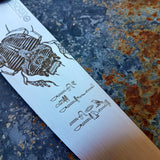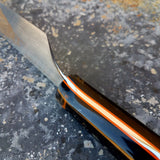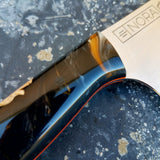







NORA # 1221 - Scarab 10' Kiritsuke
$ 434.00
KNIFE HIGHLIGHTS
- Blade Type: Kiritsuke
- Blade Length: 10 Inches
- Total Length: 15 Inches
- Handle Style: Western | Right or Left Hand Use
- Steel: AEB-L Stainless Steel
- Handle Materials: Stabilized Big Leaf Maple Burl Wood, Urethane Based Resins, Black & Orange G10 liners, black micarta pins
- Rockwell Hardness: 62 HRC
- Grind Type: Full Flat
- Weight: 8.9 oz.
- This Blade is Ground...
- Thin for Performance (best performance but delicate)
- Thick for Durability (tough, built to last for heavy wear-n-tear)
- >>>Mid-Range with Special Geometry (specially ground for food release and glide but blade is kept slightly thicker for durability)
- This Knife Feels...
- Heavy in Hand (hefty, durable)
- Light (nimble, maneuverable)
- >>>Not too heavy, not too light (Switzerland)
GENERAL USES OF THIS KNIFE
KIRITSUKE KNIFE
This NORA knife is our take on the traditional Japanese Kiritsuke knife.
A Kiritsuke knife is one of the very few Japanese knives that is considered multi-purpose. It is a hybrid between a Yanagi (fish slicer) and a Usuba (vegetable knife.). A Kiritsuke knife works well for slicing and breaking down protein but it also excels at vegetable prep. and general purpose tasks. In Japanese kitchens, the Kiritsuke knife is reserved only for the executive Chef as a sign of respect and also due to the skill needed to efficiently use these knives.
Our Kiritsuke design does not have as flat of a belly as the more traditional Japanese style knives. We have done this to allow just the slightest amount of rock in the cut. We feel it adds a bit more versatility to the knife.
STEEL INFORMATION:
AEB-L STAINLESS STEEL
This knife blade is composed of AEB-L stainless steel which is a high-quality Swedish metal, originally developed for razor blades. Recently, steel suppliers have made this steel available in thicker sheets and it has proven to be an excellent adaptation for the cutlery industry.
AEB-L has a beautiful balance of carbon and chromium and, with proper heat treatment, this steel produces both a very fine edge as well as excellent toughness and edge stability. The fine grain structure also makes this steel very easy to sharpen. We believe it is one of the finest stainless steels available on the market today for use with kitchen knives.
As a side note, there are two things we like to mention about this steel:
1.) This steel responds beautifully to honing and if the knife is honed regularly it should need infrequent sharpening.
2.) AEB-L is a stainless steel but just barely. The concept of stainless steel is actually misleading because every steel is, at some level, reactive to water and other elements.
The higher carbon content in this stainless is what allows it to get a fine edge and higher hardness than other stainless steels but it also has a tendency to sometimes form very fine rust spots on the blade. If this happens, these are easily removed with a green or red scotch brite pad and usually the rough end of a kitchen sponge will also do the trick. Take extra care to remove an excess wetness that remain on this blade. Drip drying is not recommended.
HANDLE DESIGN & MATERIALS:
Every one of our knives is handmade, unique and numbered. This NORA knife is handled with a hand-casted scale that is a hybrid of both wood and resin. The wood is a stabilized big leaf maple burl wood and the resin is urethane based with dominant hues of black accented with small veins of white, orange and silver. The pins are black micarta and the knife is lined with a double layer of G10 in both black and orange. Its a beautiful knife with a very elegant but modern feel to it.
Wood stabilization is an added feature that we offer with our knives. Wood that is stabilized has been injected with a clear acrylic resin under a vacuum process. Stabilization helps to minimize, if not eliminate, any cracking, warping, shrinkage and/or expanding of the material. Stabilized wood will not absorb water and is generally impervious to oils. The process helps to ensure your knife has a long lifespan in the kitchen.
This knife has also been custom engraved with a decorative scarab beetle, which was held sacred by the ancient egyptians. To the Ancient Egyptians, the scarab sacer was a symbol of Khepri, the early morning manifestation of the sun god Ra, from an analogy between the beetle's behaviour of rolling a ball of dung across the ground and Khepri's task of rolling the sun across the sky.
In addition to the scarab we added our own form of hieroglyphics for good effect. The engraving makes for a very cool knife and we love the overall look. I mean, who hasn't watched a national geographic special on the Egyptians and not found themselves completely engrossed. Interesting knife for an interesting culture and time.
**This knife has been custom engraved. The engraving was done via laser so there is depth to the engraving more so than you see with an electro etch. We do, however, keep the depth minimal so it does not catch food and minimally interferes with the primary cutting function of the knife. A small amount of stickage is normal around the engraved area, especially initially. This will lessen over time as the blade is used. Please note though, if performance is your #1 priority then we encourage you to NOT purchase this blade. A blade with no engraving WILL have a smoother glide than a blade with engraving. For most, however, this difference is so minimal that it is barely noticed. We just like to provide a full disclosure up front so you know exactly what you are purchasing.
The engraving should last as long as the knife but please note that it will slightly degrade over time as abrasives are used on the knife. We recommend the soft end of a sponge with soap and water for cleaning and mineral oil periodically to condition the blade (and handle). Keep in mind that stronger abrasives, such as steel wool, scotch brite pads, sand paper or stone sharpening directly on the engraved image will further degrade the image.
